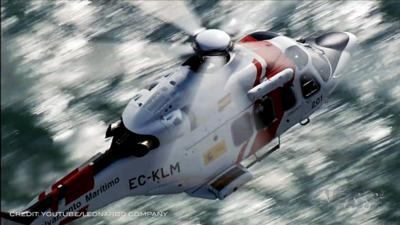Sat, Dec 09, 2023
Testing Pushes the Envelope up to 100% Blends
Leonardo and Pratt & Whitney Canada completed their first flight using 100% Sustainable Aviation Fuel using an AW139 intermediate twin helicopter.

The duo evaluated the capacity of the type's PT6C-67C engines, using 100% SAF, taking off from the Leonardo facility in Cascina Costa di Samarate. The 75-minute flight allowed crews to put the AW139 through its paces, checking engine performance with multiple power settings and evaluating subsystems for erratic behavior. Leonardo reports that the testing "showed an outstanding response to the new fuel with no significant differences compared to the use of Jet A1 fuel".
The 100% ratio is now en vogue, with many manufacturers moving on past their various titrations of traditional Jet A and SAF. In recent years, they took apparent baby steps, feeding current-gen powerplants ratios like 30% or 50% at most, to the point that it's not too rare to see them approved for public operators.
“With this latest result we are demonstrating how we can support the rapid evolution of sustainability requirements in aviation as the industry aims at a greater use of SAF in operations," said Gian Piero Cutillo of Leonardo Helicopters. "We did so with the world-class AW139 testifying that this technology allows more sustainable operations keeping the same level of high performance, significantly contributing to lower CO2 emissions. We’re committed to joining forces with aviation partners and suppliers, authorities, energy leaders, and rotorcraft service providers to incentivize the use of SAF to sustain carbon footprint reduction.”
“This first flight effectively demonstrates engine functionality and is an important part of our long-standing efforts to support the development of future specifications for 100% SAF, a core part of our sustainable propulsion strategy,” added Maria Della Posta, president of Pratt & Whitney Canada. “This is the first time a PT6 engine has flown using 100% SAF. This milestone builds on its unrivaled legacy of success and underlines how the engine family can contribute to a more sustainable future in aviation. Since entering the market 60 years ago, the PT6 engine family has clocked more than 500 million flight hours, 8.3 million of which were on PT6C turboshaft engines.”
More News
Aero Linx: Commercial Aviation Safety Team (CAST) Founded in 1997, the Commercial Aviation Safety Team (USCAST) has developed an integrated, data-driven strategy to reduce the comm>[...]
Land And Hold Short Operations Operations that include simultaneous takeoffs and landings and/or simultaneous landings when a landing aircraft is able and is instructed by the cont>[...]
We're Everywhere... Thanks To You! Even with the vast resources and incredibly far-reaching scope of the Aero-News Network, every now and then a story that should be reported on sl>[...]
Pilot’s Inadvertent Use Of The Landing Gear Control Handle Instead Of The Flaps Selector Switch During The Landing Rollout Analysis: The pilot reported that during the landin>[...]
Also: Cosmonaut Kicked Out, Airbus Scales Back, AF Silver Star, Russian A-60 Clobbered A Samaritan’s Purse humanitarian flight was hijacked on Tuesday, December 2, while atte>[...]
 ANN's Daily Aero-Linx (12.12.25)
ANN's Daily Aero-Linx (12.12.25) ANN's Daily Aero-Term (12.12.25): Land And Hold Short Operations
ANN's Daily Aero-Term (12.12.25): Land And Hold Short Operations ANN FAQ: How Do I Become A News Spy?
ANN FAQ: How Do I Become A News Spy? NTSB Final Report: Cirrus Design Corp SF50
NTSB Final Report: Cirrus Design Corp SF50 Airborne 12.08.25: Samaritans Purse Hijack, FAA Med Relief, China Rocket Fail
Airborne 12.08.25: Samaritans Purse Hijack, FAA Med Relief, China Rocket Fail



